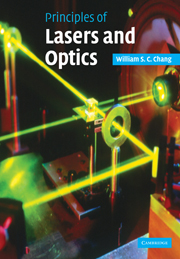Book contents
- Frontmatter
- Contents
- Preface
- 1 Scalar wave equations and diffraction of laser radiation
- 2 Gaussian modes in optical laser cavities and Gaussian beam optics
- 3 Guided wave modes and their propagation
- 4 Guided wave interactions and photonic devices
- 5 Macroscopic properties of materials from stimulated emission and absorption
- 6 Solid state and gas laser amplifier and oscillator
- 7 Semiconductor lasers
- Index
- References
1 - Scalar wave equations and diffraction of laser radiation
Published online by Cambridge University Press: 06 July 2010
- Frontmatter
- Contents
- Preface
- 1 Scalar wave equations and diffraction of laser radiation
- 2 Gaussian modes in optical laser cavities and Gaussian beam optics
- 3 Guided wave modes and their propagation
- 4 Guided wave interactions and photonic devices
- 5 Macroscopic properties of materials from stimulated emission and absorption
- 6 Solid state and gas laser amplifier and oscillator
- 7 Semiconductor lasers
- Index
- References
Summary
Introduction
Radiation from lasers is different from conventional optical light because, like microwave radiation, it is approximately monochromatic. Although each laser has its own fine spectral distribution and noise properties, the electric and magnetic fields from lasers are considered to have precise phase and amplitude variations in the first-order approximation. Like microwaves, electromagnetic radiation with a precise phase and amplitude is described most accurately by Maxwell's wave equations. For analysis of optical fields in structures such as optical waveguides and single-mode fibers, Maxwell's vector wave equations with appropriate boundary conditions are used. Such analyses are important and necessary for applications in which we need to know the detailed characteristics of the vector fields known as the modes of these structures. They will be discussed in Chapters 3 and 4.
For devices with structures that have dimensions very much larger than the wavelength, e.g. in a multimode fiber or in an optical system consisting of lenses, prisms or mirrors, the rigorous analysis of Maxwell's vector wave equations becomes very complex and tedious: there are too many modes in such a large space. It is difficult to solve Maxwell's vector wave equations for such cases, even with large computers. Even if we find the solution, it would contain fine features (such as the fringe fields near the lens) which are often of little or no significance to practical applications.
Information
- Type
- Chapter
- Information
- Principles of Lasers and Optics , pp. 1 - 33Publisher: Cambridge University PressPrint publication year: 2005
